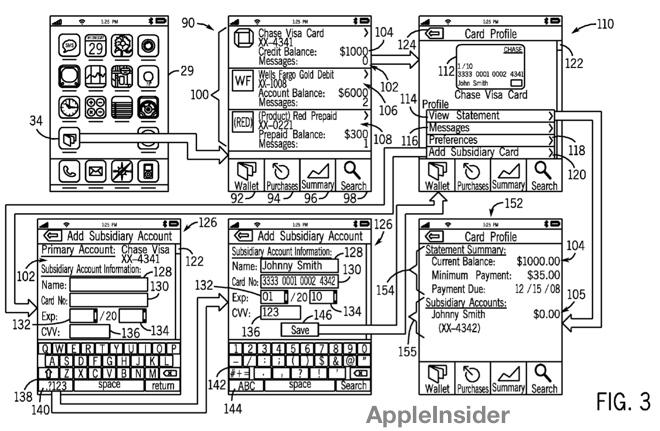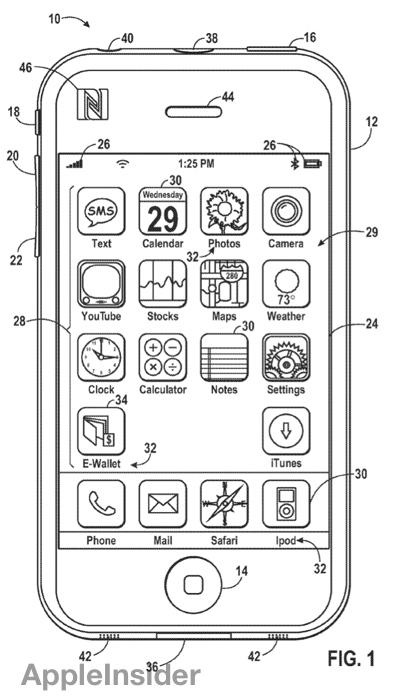Apple's idea for an "e-wallet" iPhone application would allow subsidiary accounts for children, complete with customizable spending limits and restrictions.
Apple's interest in the concept was revealed in a patent application published Thursday by the U.S. Patent and Trademark Office entitled "Parental Controls." It describes ways that a user could establish rules for subsidiary financial accounts.
The proposed invention shows a hypothetical application on the iPhone home screen named "E-Wallet." The software allows users to have a primary account tied to a credit card, allowing transactions to be conducted with an iPhone.
The key feature of the filing are the E-Wallet subsidiary accounts. By creating one, the user can allow new users, such as children, to have access to the E-Wallet app with controlled spending limits.
The customizable rules would allow a parent to set, for example, a weekly or monthly allowance for their children. The application would also enable parents to decline transactions if they are over a certain amount of money.
Parents could also restrict transactions from certain merchant categories, or even block sales to a specific merchant or location. In one example, the application is set to prevent the user from purchasing alcohol or tobacco with Apple's iPhone e-wallet.
Illustrations included in Apple's patent filing show that the concept for the E-Wallet application would include purchase history, bill summary, and the ability to search for specific transactions. The E-Wallet app would be driven by users' existing credit cards, with numbers entered into the software to link them together.
The filing goes on to note that a future iPhone could have an integrated near-field communication chip to supplement the E-Wallet app. It notes that communication using the NFC component would occur in a range of 2 to 4 centimeters.
The proposed invention, published by the USPTO this week, is a continuation of a filing first made by Apple in January of 2009, and issued as U.S. Patent No. 8,127,982 in March of 2012. It is credited to Brandon J. Casey, Gary L. Wipfler, and Erik Cressall.
 Neil Hughes
Neil Hughes









 Christine McKee
Christine McKee
 Marko Zivkovic
Marko Zivkovic
 Mike Wuerthele
Mike Wuerthele

 Amber Neely
Amber Neely
 Sponsored Content
Sponsored Content
 Wesley Hilliard
Wesley Hilliard










16 Comments
Hoping the thumbprint technology is true, they implement NFC, and expand passbook with these capabilities- making it actually useful.
The idea of a master accout (e-wallet) with subsidiary accounts is great and will simplified the lives of millions of parents. If the subsidiary account is linked to another apple id it would mean that a child account can be unhooked from the parent (master) account which I think most parents would love as much as their kids who would get greater autonomy.
Hoping the thumbprint technology is true, they implement NFC, and expand passbook with these capabilities- making it actually useful.
According to the Patent this E-Wallet App would use NFC.
The filing goes on to note that a future iPhone could have an integrated near-field communication chip to supplement the E-Wallet app. It notes that communication using the NFC component would occur in a range of 2 to 4 centimeters.
So it appears we may see NFC in a future iPhone, hopefully this year.
The idea of a master accout (e-wallet) with subsidiary accounts is great and will simplified the lives of millions of parents. If the subsidiary account is linked to another apple id it would mean that a child account can be unhooked from the parent (master) account which I think most parents would love as much as their kids who would get greater autonomy.
I think this could also mean Apple is investigating adding multiple user accounts to iOS.
According to the Patent this E-Wallet App would use NFC.
So it appears we may see NFC in a future iPhone, hopefully this year.
I wouldn't bet on it.
This is an old patent that is rather obviously using some generic terms to cover as much territory as possible. In addition, the entirety of the patent is contained in the part before they even mention NFC. It's a software patent.
It's a mistake to think that this patent relies on NFC technology just because it happens to mention it, in what amounts to an aside, at the end.
From everything I've read on the subject, NFC is an inherently insecure technology and since the NFC part could easily be swapped out for Bluetooth, WiFi, or even some other technology we haven't heard of yet without effectively changing this patent at all, it's not exactly correct to say that the publication of the patent means we are due for an iPhone with NFC.